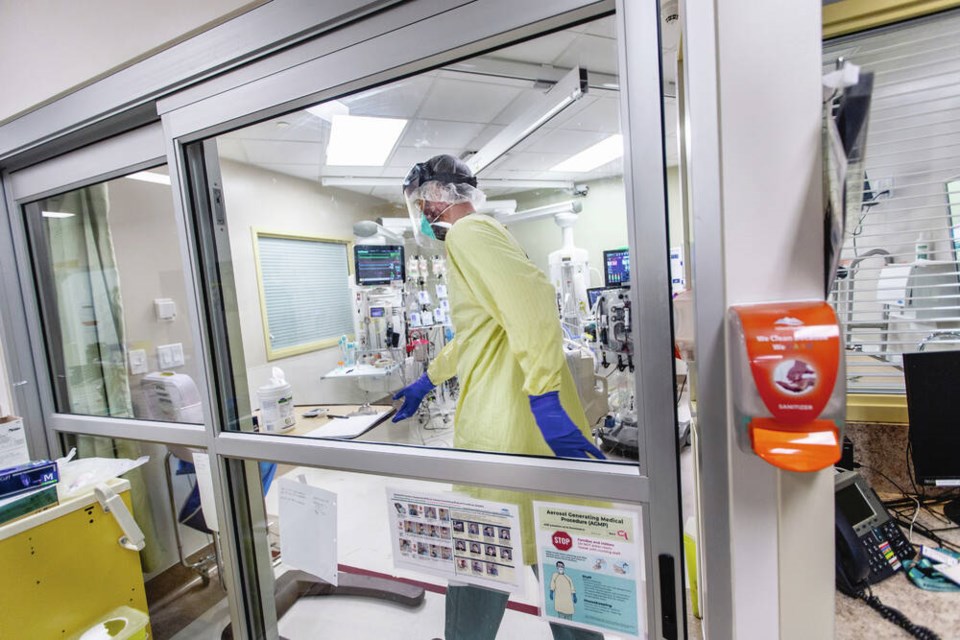The B.C. government will spend roughly $1 billion to improve working conditions and recruit more nurses into the province’s public health system, the Ministry of Health announced Tuesday.
The bulk of that funding — $750 million — is expected to be paid out over three years to improve new nurses-to-patient ratio targets. Those targets, the first of its kind in Canada, are meant to reduce nurses’ workloads, increase staff safety and retention, and improve quality of life and patient care across the province’s hospitals and long-term care homes.
Another quarter billion dollars will be paid out in one-time spending to improve national and international recruitment, open up part-time jobs to nursing students and provide funding so mid-career nurses can get training and new credentials.
“The past few years have been hard on nurses. They had been pushed to the max through global pandemic, toxic drug crisis, climate emergencies,” said B.C. Premier David Eby.
“Abandoning public health care is not our approach and it never will be. Supporting people who work in this health-care system absolutely will be.”
The funding package is part of a tentative collective bargaining agreement the B.C. government reached with over 50,000 registered, psychiatric and licensed practical nurses across the province on March 31, 2023.
On Tuesday, a spokesperson for the Nurses' Bargaining Association said its members would vote on the agreement at the end of April. Much of the funding announced by the province will not be unlocked unless the nurses' union ratifies that agreement.
“This is an exciting time, an absolutely exciting time. The investments in health care, the investments in nurses represent an unsurpassed and historical set of investment, which we're very excited about,” said Jim Gould, chief negotiator for the Nurses' Bargaining Association.
B.C. nurses facing multiple crises
The B.C. government says the new money is meant to target a number of crises facing the public health-care system in recent years.
The opioid crisis, COVID-19 pandemic and 2021 heat wave have combined with an aging population to put increased pressure on nurses, according to the ministry. An estimated 20 per cent of nurses in B.C. are over 55, and 41 per cent are over 45.
“We have to do more and we have to do better,” said B.C.’s Minister of Health Adrian Dix.
To fill those ranks, the province says it must compete with other jurisdictions in Canada and abroad. Officials said the new measures are meant to make B.C. a more competitive place so nurses elsewhere in Canada and overseas choose B.C. as a place to work.
The Ministry of Health is earmarking $15 million for a national and international recruitment campaign to bring in new nurses to the province. As of February 2022, there were 2,000 seats to train nurses across B.C.
Another $20 million will go toward student nurses, so they can take on part-time positions in the health system while going to school. The program is meant to act as a pipeline to recruit new nurses into B.C.’s public health system, say officials.
The funding package is also designed to retain nurses already in the health system. That includes $60 million to support a fund for nurses who need extra mental health support or to top up other benefit programs.
If ratified, the nurses’ bargaining agreement also sets out wage increases of 12.9 per cent between 2022 and 2024.
In addition to the boosted wages, the agreement includes anti-racism language, five days of paid leave for ceremonial, cultural or spiritual purposes for Indigenous employees, and changes that allow employers to preferentially hire Indigenous employees.
An Australian model
Most of the money announced Tuesday will back the new nurse-to-patient ratio system, which officials say has been modelled off similar targets in place in Australia and California.
“This is the leading international practice in terms of retention of nurses in the delivery of quality health care,” said Dix. “It's a practice that has been put in place for example, in Australia, and it's been an issue on which the BC Nurses' Union has been advocating for decades.”
Over the next year, the province says targets for hospital-based nurses will range from a one-to-one ratio in ventilated critical-care settings to a one-to-five ratio for nurses working with patients in rehabilitation. Targets for health-care settings outside of hospitals are still being worked out, officials said.
Officials did not answer reporters' questions over how many new nurses are required to hit staffing targets.
“We don’t have that model now,” said Dix.
Australia currently runs on a three-shift-per-day system, with larger nurse-to-patient ratios at certain times of day. The province is still working out how B.C.’s two-shift model might adjust nurse-to-patient ratios at busier times of the day or night.
It’s also not clear if or how nurses will be report when ratios exceed the province's targets.
In a technical briefing where reporters are prohibited from naming individuals, an official said the nurse-to-patient ratios will not lead to caps on patient admissions.
Any funding earmarked for improving nurse-to-patient ratios that’s not used over its fiscal period will be directed to nurse recruitment or the new fund for nurses, the official said.



